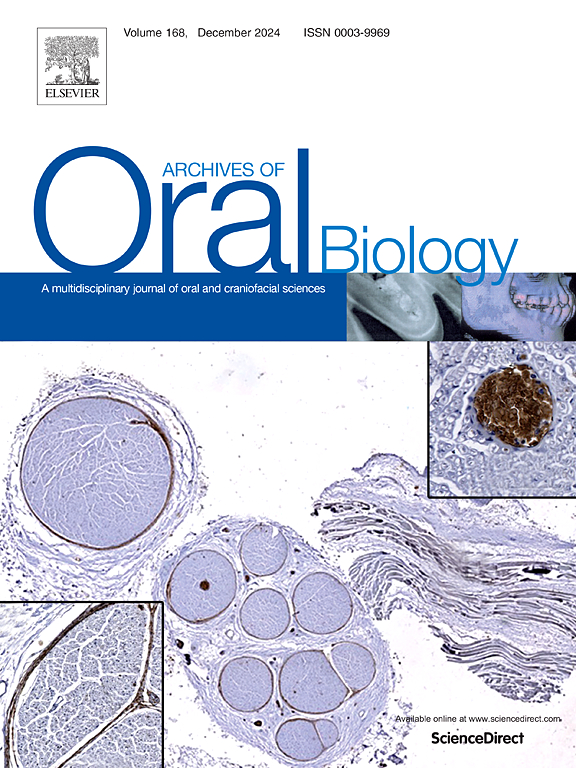年轻和成年雄性大鼠臼齿拔除后上颌牙槽骨的纵向变化
IF 2.1
4区 医学
Q2 DENTISTRY, ORAL SURGERY & MEDICINE
引用次数: 0
摘要
目的研究单侧磨牙拔牙后上颌牙槽骨尺寸的变化,考虑同侧与对侧牙槽突横截面积(CSA)和牙槽嵴高度与年龄的关系。设计取28只4周龄雄性大鼠(幼龄)和28只26周龄雄性大鼠(成年),每龄随机分为对照组(n = 12)和试验组(n = 16)。实验组大鼠单侧拔除右上磨牙,12周后安乐死。在拔牙后立即、拔牙后4周、8周和12周用活体显微ct对颅骨进行纵向扫描。采用上颌第一磨牙的5个标准化横切面测量CSA和牙槽骨高度。结果幼鼠和成年对照大鼠CSA和牙槽骨高度均呈持续升高趋势,成年对照大鼠CSA和牙槽骨高度升高幅度较小。磨牙拔牙导致幼龄和成年大鼠无牙区CSA和牙槽嵴高度显著降低,而拔牙侧对侧CSA和牙槽嵴高度升高,与对照组相似。拔牙12周后,幼鼠的CSA下降幅度比成年大鼠更大。结论用无牙侧牙槽突CSA和牙槽突高度的变化测量单侧上颌磨牙缺失使牙槽骨量减少。这些措施增加了对侧提取和控制侧,与年龄和功能有关的一些差异。本文章由计算机程序翻译,如有差异,请以英文原文为准。
Longitudinal changes in maxillary alveolar bone after molar extraction in young and adult male rats
Objective
To study the changes in maxillary alveolar bone dimensions after unilateral molar extraction, considering the ipsilateral versus contralateral alveolar process cross-sectional area (CSA) and the height of the alveolar bone crest in relation to age.
Design
A total of 28 4-week-old (young) and 28 26-week-old (adult) male rats were randomly assigned to control (n = 12) and experimental (n = 16) groups at each age. The experimental groups underwent unilateral upper right molar extraction, and all rats were euthanized after 12 weeks. The skulls were longitudinally scanned immediately after extraction and at 4, 8, and 12 weeks after extraction using in vivo micro-CT. The CSA and alveolar bone height were measured using five standardised transverse sections of the maxillary first molars.
Results
The CSA and alveolar bone height in the young and adult control rats constantly increased, although to a lesser extent in the adults. Molar extraction caused a substantial decrease in the CSA and alveolar ridge heights in the edentulous region in young and adult rats, whereas those contralateral to the extraction side increased in the young and adult rats similar to that in the controls. The reduction in the CSA 12 weeks after extraction was more extensive in young than in adult rats.
Conclusion
The unilateral loss of maxillary molars reduced alveolar bone mass, as measured using the changes in the alveolar process CSA and alveolar process heights on the edentulous sides. These measures increased contralateral to the extraction and control sides, with some differences related to age and function.
求助全文
通过发布文献求助,成功后即可免费获取论文全文。
去求助
来源期刊

Archives of oral biology
医学-牙科与口腔外科
CiteScore
5.10
自引率
3.30%
发文量
177
审稿时长
26 days
期刊介绍:
Archives of Oral Biology is an international journal which aims to publish papers of the highest scientific quality in the oral and craniofacial sciences. The journal is particularly interested in research which advances knowledge in the mechanisms of craniofacial development and disease, including:
Cell and molecular biology
Molecular genetics
Immunology
Pathogenesis
Cellular microbiology
Embryology
Syndromology
Forensic dentistry
 求助内容:
求助内容: 应助结果提醒方式:
应助结果提醒方式:


